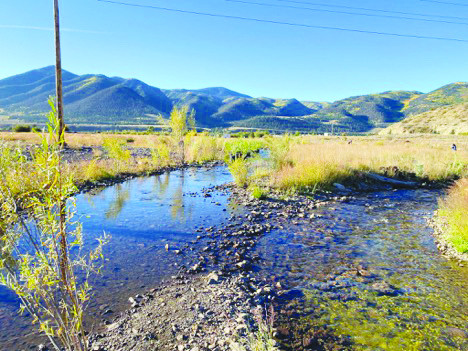Floodplain restoration is full steam ahead

CREEDE — What can trees really do? We all know they provide shade, take in carbon dioxide, and exhale oxygen, right? But what else can these stolid giants provide?
For years, the lower Willow Creek floodplain just south of Creede has been devoid of most trees due to generally unfavorable conditions — acidic water, heavy metals, and a lack of soil. However, restoration work can push the floodplain into a new future — one in which trees have a healthy home. Headwaters Alliance made numerous strides this summer on the floodplain, transplanting willow bundles and stakes, hosting an ecological restoration training through Volunteers for Outdoor Colorado, and just last week, planting more than 200 new trees ranging from spruces to aspens.
In collaboration with Rio Grande Headwaters Land Trust and San Luis Valley Great Outdoors Action Team (G.O.A.T.s), Headwaters Alliance spent four days strategically planting trees in key areas on the floodplain. The project was funded by a Five Star grant from the National Fish and Wildlife Foundation, a non-profit working to protect and restore habitat, and by American Forests, a non-profit focused on creating healthy and resilient forests. Locations for the new trees were chosen based on soil conditions and future engineering plans for the floodplain in an effort to maximize their survival and proliferation.
The team planted:
- 100 Coyote Willow clumps that were dug from nearby sites;
- 25 Rocky Mountain Willows;
- 25 Blue Stem Willows;
- 25 Coyote Willows;
- 8 Aspens;
- 8 Blue Spruce;
- 8 Colorado Spruce; and
- 10 Cottonwoods.
Yes, these new trees will provide shade and serenity, but more importantly, they will help shape the future of the floodplain. Trees have amazing qualities beyond the obvious:
- Tree roots stabilize streambanks, reducing erosion and providing habitat and soil for more plants;
- As more plants colonize newly stabilized regions, more animals find habitat and food;
- Roots, especially willow roots, can help filter water by removing toxic compounds which can lead to better habitat for bugs and fish;
- Tree roots and the stabilized soil absorb extra water, releasing it more slowly which can help slow flood waters, making them less erosive while also holding water as a defense against drought; and
- How can we forget about the shade! The trees not only provide shade for people, but that shade also helps the stream stay cooler, providing better habitat for fish.
Trees are amazing living creatures, as beautiful as they are varied. Headwaters Alliance is proud to help secure a better future for our shared floodplain — one that is resistant against floods and drought, helps clean our water, and provides habitat for bugs, fish, and deer. Trees are vital for that future! Take a moment to walk the multi-use floodplain trail in Creede and observe the newly planted neighbors who may just be the tipping point, pushing the floodplain into a new existence.
Stay tuned for more restoration events from Headwaters Alliance.
For more information on this topic, contact the Development and Engagement Coordinator, Alex Handloff, at the Headwaters Alliance at [email protected].



